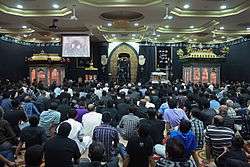Hussainiya
| Hussainia | |
|---|---|
 Hussainia in Dar es Salaam, Tanzania | |
| Arabic (عربي) | حسينية (ḥussainiā) مأتم (ma'tam) |
| Hindi (हिंदी) | इमामबाड़ा (imāmbāṛā) आशुरख़ाना (āshurkhānā) |
| Persian (فارسى) | حسینیه (ḥosseiniyeh) |
| Urdu (اُردوُ) | امامباڑا (imāmbāṛā) امامبارگاہ (imāmbārgāh) عاشور خانہ (āshurkhānā) حسينيہ (ḥussainiā) |
| A series of articles on |
| Husayn ibn Ali |
|---|
 Husayn ibn Ali in Islamic calligraphy
Husayn ibn Ali in Islamic calligraphy |
| Life |
| Remembrance |
|
| Perspectives |
|
|
A hussainia (Persian: حسینیه), also known as an ashurkhana, imambargah, or imambara, is a congregation hall for Shia commemoration ceremonies, especially those associated with the Remembrance of Muharram.[1] The name comes from Husayn Ibn Ali, the grandson of Muhammad and the third imam of the Shia Muslims. Imam Hussain was killed by the Umayyad caliph Yazid I at the Battle of Karbala in Iraq, on October 10, 680 AD. Shias commemorate the martyrdom of Imam Hussain every year on the day of Ashura in hussainias all over the world.[2]
A hussainiya is different from a mosque in that it is intended mainly for gatherings for Muharram in the mourning of Hussain ibn Ali, and may not necessarily hold juma'at, or Friday prayers.
In South Asia, a hussainia can also be referred to as an imambara, imambargah, or ashurkhana. In Bahrain, and the United Arab Emirates, it is called a ma'tam (مأتم). In Lebanon, its called Arabic: حسينية – hussainiā. In Afghanistan and Central Asia, the equivalent term for a Shia congregation hall is takyakhana.
Notable Hussainias
.jpg)

- Hussaini Dalan, in Dhaka, Bangladesh
- Bara Imambara, in Lucknow, India
- Chhota Imambara, in Lucknow, India
- Nizamat Imambara, in Murshidabad, India
- Badshahi Ashurkhana, in Hyderabad, India
- Hosseiniyeh Ershad, in Tehran, Iran
- Hussaini Imambara, in 100/46, Colonel Ganj Kanpur,
- Imambara Ghufran Ma'ab, in Lucknow, India
- Imambargah Colonel Maqbool Hussain, in Rawalpindi, Pakistan
- Imambargah Mir Vilayat Husain, in Karari Allahabad, India
- Azakhana Wazeer-un-Nisa, located in Amroha, India. The Azakhana was built in 1802 (1226 Hijri) with one Mosque.
- Imambargah Haveli Sa'daat, one of the oldest Imambargahs in Gujranwala, Pakistan. It was built by the Naqvi Sadat family, who migrated from Fateh garh churian, Punjab, India.
- Imambargah Bait Aal e Imran, in Kotla Arab Ali Khan, Gujrat, Pakistan. The site was donated by Choudhary Ghulam Hassan, a Shia by birth, and his wife in 1979.

See also
- Ashura
- Mourning of Muharram
- Battle of Karbala
- Husayn ibn Ali
- Hoseni Dalan
- Tasu'a
- Imambaras of Lucknow
- Rawda Khwani
References
- ↑ Juan Eduardo Campo (1 January 2009). Encyclopedia of Islam. Infobase Publishing. pp. 318–. ISBN 978-1-4381-2696-8.
- ↑ Calmard, Jean (15 December 2004). ḤOSAYNIYA. Retrieved 5 October 2015.
| Wikimedia Commons has media related to Shi'a hussainia. |
